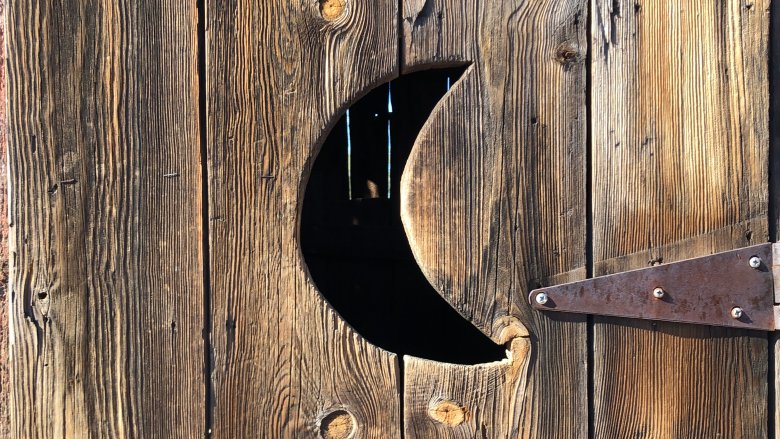This Is Why Outhouses Had A Crescent Moon On The Door
Of all the things you will learn today, perhaps none is so compelling as this.
Just kidding. There's really nothing intellectual or of great historical import in understanding why outhouses had crescent moon shapes on their doors. In fact this is really only likely to conjure up collective memories of dangerous open pits and horrible stink, which what most human beings think of when they see or hear the word "outhouse." And then maybe after that, the crescent moon.
Still, what is up with that crescent moon? Why is it that any outhouse that does not arrive on the back of a truck driven by some poor dude who regrets his career choices every single day must always have that weird little crescent moon cutout?
According to Atlas Obscura, the long-running legend about the crescent moon is that it was once used to separate the women's outhouses from the men's outhouses, much in the same way as the oddly triangle-shaped human figure stamped on today's restrooms is used to direct women to the bathrooms that have the longest lines, while the non-triangle shaped human figure marks the bathrooms that dudes can casually breeze in and out of.
Supposedly, the men's outhouses once had a sun or star symbol, but the women's half moon shape is the one that survived into public consciousness because men have way worse bathroom habits than women do and their outhouses all eventually disintegrated, thus being lost to time while only the women's outhouses remained standing. Now, just to clarify, we are not actually saying that we personally think that men have way worse bathroom habits than women do, we're just repeating the stupid legend.
The moon as a symbol for "female" has pretty ancient origins, but it's unclear whether or not it was the sort of symbology that 19th-century people would understand or be on board with. It makes sense that in places where literacy rates weren't really high that you would want to use a symbol to separate female spaces from male spaces, but on the other hand, it does sort of seem like the whole Goddess Diana thing wouldn't really be a cowboy thing, so it's hard to say whether this explanation is based on reality or if it's just something someone made up.
Folklorist Dr. Adam Davis, who wrote a whole article on the subject in 2007 (and don't laugh because a couple of people have actually written entire books about outhouses), says there really isn't much evidence to back up the widespread theory about the crescent moon as a symbol for the women's outhouse. In fact the explanation only goes back as far as 1972, which is kind of a long way past the heyday of the classic, smelly, rickety wooden outhouse as we once knew it. Also, in those days no one really bothered with digging two outhouses because the process was just too expensive and time-consuming, so for that reason it seems even less likely that the half moon was supposed to direct women to the females-only outhouse, when there probably was only rarely a separate outhouse designated for the ladies.
Now it is true that outhouses had holes cut into the doors — they had to, because otherwise the smelly, gag-inducing experience of using a public outhouse would have been slightly more smelly and gag-inducing. They also let in a little bit of light so you could see to do your business. And there is plenty of photographic evidence that those pre-1900s outhouses did have semicircles cut in the doors, like somewhat less curvy half-moons.
The best guess for the practice, though, is this super-boring one: It looked nice. Or as nice as you could make a smelly shack full of human excrement look. And then it got spread through pop culture in the mid-1900s. Someone at one time probably saw their neighbor's outhouse with a crescent moon carved into it and said, "Hey that's cool, do you mind if I put one of those on my outhouse?" and the neighbor said, "Why the heck are you asking me, I don't give a crap what you carve into your stink-shack." And thus the crescent moon cutout spread across the land and into movies and textbooks and Westerns, and eventually someone felt like they had to make up a story to help explain it.
Mystery solved.
